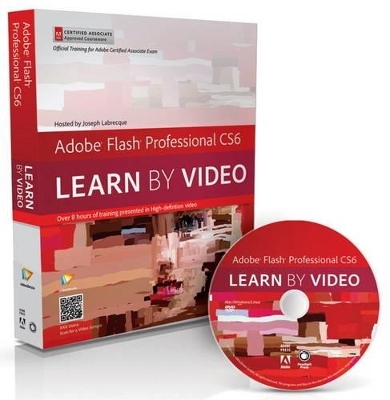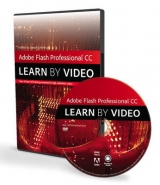
Adobe Flash Professional CS6
Peachpit Press Publications
978-0-321-84070-7 (ISBN)
- Titel erscheint in neuer Auflage
- Artikel merken
Experienced instructor Joseph Labrecque presents all the foundational features in Flash Professional CS6 through workable examples. The student gains a solid understanding of the tools so they can continue along any path: animation, gaming, application and mobile development, or working with premium video solutions.
Joseph starts with a survey of all major application interface elements, asset creation and manipulation, and document properties and file types. He continues with a deep look into the Flash Library and the use of different symbol types across projects to exploit robust animation techniques using the timeline. Next, he explores the inclusion of sound and video, the ActionScript programming language, and application development for mobile devices. Finally, Joseph demonstrates testing and debugging applications before compiling and publishing onto a variety of platforms.
video2brain, located in Graz, Austria, is a company focused on producing high-quality video training content for software, photography and programming topics. Crucial to the flexible training are optimized teaching methods, practical tips from well-known industry experts, and the focus on learning by doing with project files. video2brain is an Adobe Certified Training Provider. Joseph Labrecque is a senior interactive software engineer at the University of Denver, where he produces innovative academic toolsets for both traditional desktop environments and emerging mobile spaces. He has served as an Adobe Education Leader since 2008 and is also a 2011 Adobe Community Professional.
1 introducing Flash Professional CS6
1.1 What Is Adobe Flash Professional?
1.2 What’s the Course About?
1.3 What’s New in Flash Professional CS6
2 Flash Professional Application Overview
2.1 Application Interface Overview
2.2 Welcome Screen
2.3 Flash Professional File Formats
2.4 Accessing Help
3 Getting Familiar with Flash Professional
3.1 The Application Menu
3.2 The Toolbar
3.3 The Stage
3.4 The Timeline
3.5 Working with Panels
3.6 The Properties Inspector
3.7 Colors and Swatches
3.8 Managing Workspaces
4 Exploring Basic Tools
4.1 The Selection, Subselection, and Lasso Tools
4.2 The Line and Shape Tools
4.3 The Pencil, Brush, and Eraser Tools
4.4 The Paint Bucket and Ink Bottle Tools
4.5 The Eyedropper Tool 4.6 The Hand and Zoom Tools
5 Exploring Advanced Tools
5.1 The Text Tool
5.2 The Pen and Anchor Point Tools
5.3 The Free Transform and Gradient Tools
5.4 The 3D Rotation and Translation Tools
5.5 The Bone and Bind Tools
6 Project Explorations
6.1 Setting the Stage
6.2 Drawing the Assets
6.3 Making It Move
6.4 Adding Interactivity
7 Working in Flash Professional
7.1 Creating a New Document
7.2 Using Flash Templates
7.3 Working with Guides and Rulers
7.4 Testing a Project
7.5 Creating a Project Plan
8 Working with Assets
8.1 Vector vs. Bitmap
8.2 Lines and Fills
8.3 Merge Mode vs.Object drawing Mode
8.4 Modifying Shapes
8.5 Grouping Assets
8.6 Importing Assets
8.7 Using Trace Bitmap
8.8 Using Break Apart
9 Symbols and the Library
9.1 The Flash Library
9.2 Graphic Symbols
9.3 Button Symbols
9.4 Movie Clip Symbols
9.5 Sprite Symbols
9.6 Using Filter Effects
9.7 Using Blend Modes
10 Working with Text
10.1 Creating Text Fields
10.2 Text Field Properties
10.3 Spell-Checking Text
10.4 Applying Filter Effects to Text
10.5 Embedding Fonts
10.6 Text Layout Framework
11 Animating in Flash Professional
11.1 Frames and Labels
11.2 Layers and Folders
11.3 Scenes
11.4 Frame-by-Frame Animation
11.5 Onion Skinning
11.6 Shape Tweens
11.7 Classic Tweens
11.8 Motion Tweens
12 Advanced Animation Techniques
12.1 Nesting Animations
12.2 Using the Motion Editor
12.3 Classic Motion Guides
12.4 Motion Presets
12.5 Shape Hints
12.6 Masking
12.7 Inverse Kinematics
13 Using Sound and Video
13.1 Importing Sound Files
13.2 Using Sound Within Symbols
13.3 Adobe Media Encoder
13.4 Importing Video Files
14 Action Script Basics
14.1 The Actions Panel
14.2 Timeline-Based ActionScript
14.3 Code Snippets
14.4 ActionScript Classes
14.5 Controlling Sound with AS3
14.6 Controlling Video with AS3
15 Authoring fo rMobile devices
15.1 Mobile Targets
15.2 Mobile Code Snippets
15.3 Mobile Content Simulator
15.4 Testing on a Device
16 Debugging Flash Projects
16.1 Trace Statements
16.2 The Flash Professional debugger
16.3 Debugging on Devices
16.4 Troubleshooting Errors
17 Compiling and Publishing
17.1 Optimizing Content
17.2 Publishing for the Flash Player
17.3 Publishing for AIr desktop
17.4 Publishing for AIr Mobile
17.5 Exporting Sprite Sheets
17.6 Generating Image Sequences
17.7 Using the CreateJS Extension
17.8 Ensuring Accessibility
18 Closing Thoughts
18.1 Closing Thoughts
| Erscheint lt. Verlag | 9.8.2012 |
|---|---|
| Verlagsort | Berkeley |
| Sprache | englisch |
| Maße | 188 x 233 mm |
| Gewicht | 334 g |
| Themenwelt | Informatik ► Office Programme ► Outlook |
| Informatik ► Web / Internet ► Web Design / Usability | |
| ISBN-10 | 0-321-84070-4 / 0321840704 |
| ISBN-13 | 978-0-321-84070-7 / 9780321840707 |
| Zustand | Neuware |
| Haben Sie eine Frage zum Produkt? |
